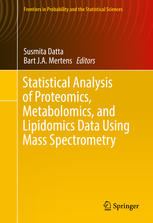

Most ebook files are in PDF format, so you can easily read them using various software such as Foxit Reader or directly on the Google Chrome browser.
Some ebook files are released by publishers in other formats such as .awz, .mobi, .epub, .fb2, etc. You may need to install specific software to read these formats on mobile/PC, such as Calibre.
Please read the tutorial at this link: https://ebookbell.com/faq
We offer FREE conversion to the popular formats you request; however, this may take some time. Therefore, right after payment, please email us, and we will try to provide the service as quickly as possible.
For some exceptional file formats or broken links (if any), please refrain from opening any disputes. Instead, email us first, and we will try to assist within a maximum of 6 hours.
EbookBell Team

4.3
58 reviewsThis book presents an overview of computational and statistical design and analysis of mass spectrometry-based proteomics, metabolomics, and lipidomics data. This contributed volume provides an introduction to the special aspects of statistical design and analysis with mass spectrometry data for the new omic sciences. The text discusses common aspects of design and analysis between and across all (or most) forms of mass spectrometry, while also providing special examples of application with the most common forms of mass spectrometry. Also covered are applications of computational mass spectrometry not only in clinical study but also in the interpretation of omics data in plant biology studies.
Omics research fields are expected to revolutionize biomolecular research by the ability to simultaneously profile many compounds within either patient blood, urine, tissue, or other biological samples. Mass spectrometry is one of the key analytical techniques used in these new omic sciences. Liquid chromatography mass spectrometry, time-of-flight data, and Fourier transform mass spectrometry are but a selection of the measurement platforms available to the modern analyst. Thus in practical proteomics or metabolomics, researchers will not only be confronted with new high dimensional data types—as opposed to the familiar data structures in more classical genomics—but also with great variation between distinct types of mass spectral measurements derived from different platforms, which may complicate analyses, comparison, and interpretation of results.